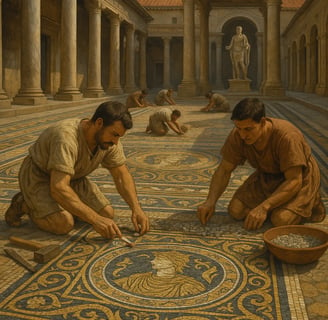Why Italian Tiles are so Famous? | The Heritage behind the Craft
Italian tiles maker are trendsetters, not trend followers. The Romans first utilized fired clay tiles in their construction, not just as a utilitarian function but also as an expression of beauty in art.
Asil atique
5/16/20254 min read


Italian tiles are renowned worldwide for their superior quality, timeless design, and cutting-edge craftsmanship. With a rich history of artistry and innovation, Italy produces tiles that combine beauty, durability, and high-end finishes, making them a top choice for luxury interiors and architecture.
Among interior design elements, few materials have the glamour and widespread appeal of Italian tiles. Used in luxury residences, designer boutique hotels, and fashion commercial buildings around the world, these tiles are not so much a surface finish—they're a declaration of time-tested good taste and artisanal skill.
In this blog, we’ll explore what makes Italian tiles so famous and why they continue to be a top choice for designers, builders, and homeowners alike.
A Rich History of Craftsmanship
It's a cultural connection that Italy has had with tiling for centuries, even to the Roman Empire times. It was the Romans who first utilized fired-clay tiles as part of their construction, and not just as a utilitarian function but even as an expression of beauty in art. Adorning public baths, villas, and temples were the mosaics, the first indication of how well ceramics were ingrained in Italian culture and society.
Flash forward to the Renaissance, and Italian tile-making was not just a craft; it was an art form that was well-respected. Enjoined by painting, sculpture, and even fashion, ceramic craftsmen started experimenting with glazes, pigments, and patterns that captivated the nation's changing artistic sensibility.
One of the towns, Sassuolo, in the very center of Emilia-Romagna, eventually became the hub of the world ceramic industry. A few tiny workshops that originally received the business now constitute a chain of globally recognized brands and high-tech factories. Sassuolo is now widely referred to as the "Tile Capital of the World."
What distinguishes Italian tiles is not just the employment of higher-quality material, but the multi-generational family skill passed down through generation after generation of artisans, who for decades have honed their craft. Every tile bears the imprint of this legacy, infused with technique, rooted in tradition, and perfected by ongoing innovation.
State-of-the-Art Design and Trends
Italian tile makers are trendsetters, not trend followers. With a design rooted in art and architecture, Italy has been a trendsetter for centuries. This is reflected in every tile collection where style meets innovation.
From Baroque palace-inspired motifs to ultra-modern minimalist designs, Italian tiles have something for everyone. You’ll find:
Terrazzo effects that pay homage to Venetian floors
Hyper-realistic marble and stone imitations that look like the real deal
Geometric patterns and optical illusions for modern interiors
Metallic glows and 3D finishes add drama and depth
Italian tile producers partner with world-leading designers and architects to create proprietary ranges debuted at international design shows like Cersaie and Salone del Mobile. Not tiles, a story on the surface.
Outstanding Quality and Durability
It is not a cliché; Italian quality is obtained through rigid standards and leading-edge technology. Italian manufacturers use the latest generation kilns, precise cutting, and digital printing to create tiles that are durable as well as beautiful.
How Italian tiles excel:
Increased hardness and scratch resistance, and protection from moisture and stains.
Colour stability, even in exterior environments and heavy-use locations.
High slip resistance in wet conditions
Low maintenance without sacrificing style
Regardless of whether they're installed in a busy kitchen, upscale bathroom, or even an outside patio, Italian tiles endure long-term without compromising style.Application Versatility
Italian tiles are the designer's good friend because of their versatility of material, size, and finish. Italian tiles offer a deep palette to suit any vision. To establish a rustic ambiance, terracotta tiles bring warmth and personality, with the look of traditional Mediterranean style. Concrete-look porcelain tiles provide a modern, industrial feel to industrial designs. Marble-effect tiles bring timeless elegance to traditional interior spaces. Italian tiles with this selection blend seamlessly with any theme, bringing beauty and functionality to any space.
Porcelain tiles for floors and outdoors
Ceramic tiles for walls and backsplashes
Glass mosaics for spa-style bathrooms and accent walls
Wood-look tiles for warm, low-maintenance spaces
They come in matte, glossy, satin, textured, and mini mosaics to large slabs that mimic marble or concrete. This means you can transition from indoors to outdoors or traditional to modern designs smoothly.
The luxury factorItalian tiles are classy. For architects and designers who want to guarantee quality and aesthetic perfection, Italian-made tiles are a strategic option. Complimented by their flawless finish, these tiles are not just products, they are symbols of status that reflect the best of European craftsmanship.
Italian tiles are adorning the walls of:Luxury hotels and spas
Fashion designer boutiques
Celebrity homes
Award-winning architectural designs
Even their packaging and brand are luxurious. From the glaze to the tile thickness, all aspects of Italian tiles shout premium quality and will bring instant luxury to any space.
Sustainability and InnovationItalian tile producers are pioneering green production through the integration of new technologies and environmentally friendly working practices. They have managed to recycle almost all production waste and wastewater, cutting dependence on virgin raw materials considerably. Solar energy is prevalent in most of the factories, coupled with closed-loop water systems and 100% raw material waste recycling. Emphasis on sustainability is complemented by innovation.
Technological highlights:Antibacterial surface tiles are ideal for kitchens and hospitals
Heat-reflection tiles for warmer climates outside
Tiles printed digitally, minimizing waste while maximizing design possibilities
Environmentally friendly certifications such as LEED, EPD, and Greenguard are now more usual among Italian tile manufacturers, testimony that design and sustainability can be wonderful together.
ConclusionItalian tiles have earned their fame through a perfect blend of heritage, innovation, and impeccable design. They’re more than building materials, they’re a celebration of form, function, and tradition. Whether you’re designing a modern loft, a coastal retreat, or a classic villa, Italian tiles bring authenticity and elegance to every surface they touch.
